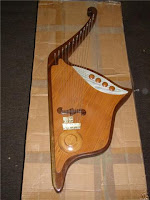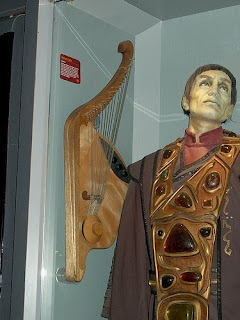Another great article by Scott Lukas Williams
Wah Chang is one of the great unsung heroes of Star Trek. Born in 1917, Chang showed an immense capacity for creative thinking and problem solving from a young age. By the time he was seven years old, Chang was already experimenting at creating art in various mediums and those around him encouraged him to continue. In the 1930s, Chang began to experiment with puppets and stop-motion photography. He worked for Disney creating wooden puppets for the animators to study as they worked on Pinocchio and Fantasia. From there, he went on to design toys and puppets, some of which were used for commercials. In 1957, Chang and two friends formed a company called Project Unlimited, Inc. Together, they created costumes, props and special effects for films and television. Most notably, they did extensive work on The Time Machine for which they would win an Oscar. Chang co-designed the elaborate headdresses for Elizabeth Taylor in Cleopatra and went on to do a great body of work for producer Bob Justman on The Outer Limits.
Wah Chang is one of the great unsung heroes of Star Trek. Born in 1917, Chang showed an immense capacity for creative thinking and problem solving from a young age. By the time he was seven years old, Chang was already experimenting at creating art in various mediums and those around him encouraged him to continue. In the 1930s, Chang began to experiment with puppets and stop-motion photography. He worked for Disney creating wooden puppets for the animators to study as they worked on Pinocchio and Fantasia. From there, he went on to design toys and puppets, some of which were used for commercials. In 1957, Chang and two friends formed a company called Project Unlimited, Inc. Together, they created costumes, props and special effects for films and television. Most notably, they did extensive work on The Time Machine for which they would win an Oscar. Chang co-designed the elaborate headdresses for Elizabeth Taylor in Cleopatra and went on to do a great body of work for producer Bob Justman on The Outer Limits.
Chang’s association with Justman led to work on the first Star Trek pilot in 1964. He designed the make-up for the Talosians and also the first phaser. Though uncredited for his work, Chang went on to design many of the most famous props and creatures for TOS, including: the Communicator, the Tricorder, the Romulan Bird of Prey, Romulan helmets, the Salt Vampire, the Gorn, Balok, the Tribbles and finally, Mr. Spock’s Vulcan Lyre.
The Vulcan Lyre (also sometimes called a harp or lute) made its first appearance in the early episode “Charlie X.” It made several other appearances in TOS (“The Conscience of the King,” “Amok Time” and “The Way to Eden”). Chang’s original prop was made of a single piece of solid wood and featured a filament strung up and down multiple times to give the impression of many strings. It was not a functional instrument. After TOS, it was painted black and featured in an episode of Mork and Mindy (many Star Trek props and costumes found their way on to this show).
The next time we would see a Vulcan Lyre was in the 1988 TNG episode “When the Bough Breaks.” It can be seen behind Melian (Paul Lambert) the Aldean musician as he instructs Katie (Jandi Swanson). Mike Okuda borrowed this replica for the set from Gene Roddenberry who kept it in his office.
In 1989 Paramount engaged the services of Dominick Giovanniello at Creative Guitar Studios in San Diego to create licensed replicas of the prop. Unfortunately, the company only held the license for about two years before going out of business but in that time they created at least 25 replica lyres. These are working instruments that make sound when plucked though all the knobs are non-functional. Instead of being solid, they are hollow which allows for the strings to vibrate and create sound. They are strung with 12 wire-wound steel electric guitar strings. Besides only having 12 strings there are a couple of other differences between this replica and Chang’s original. First is that the bottom corner is rounded where the original is pointed. Also, on the original, where the neck meets the body, the neck is thicker than the body. Because these replicas are hollow they have a thin piece of wood on the front and back which makes the body thicker than the neck. These images come from one of Giovanniello’s lyres when it was sold on eBay.
In Star Trek V: The Final Frontier (1989) Spock plays his Vulcan Lyre around the campfire with Kirk and McCoy in the final scene. Based on the appearance of the bridge and the number of strings it seems this was one of the Creative Guitar Studios replicas. However, I have not been able to confirm this.
One of Giovanniello’s lyres was purchased by Doug Drexler who loaned it to the Star Trek prop department for use on ST: DS9 and ST: Voyager. Drexler’s replica was used in the ST: DS9 episode “Through the Looking Glass.” Intendant Kira Nerys (Nana Visitor) had several Vulcan slaves in the Mirror Universe. The lyre can be seen in her quarters in this episode.
Drexler’s replica was also used for two appearances on ST: Voyager where it belonged to Tuvok (“Persistance of Vision” and “Riddles”). Following its appearances on ST: Voyager, Drexler retrieved his lyre from Property Master Alan Simms. It was later sold by Propworx to Star Trek Prop and Costume Forum member, Donna Sakaida.
When the Star Trek Experience opened in Las Vegas in 1998 it included a museum of props and costumes. One of Giovanniello’s replicas was modified for use in this display. This version has 17 strings rather than 12 and the bridge has been altered so the strings originate under the round disc as they did on Chang's original. You can see from the blonde wood that these replicas did vary somewhat.
Also for the Experience, Paramount commissioned HMS Creative Productions to create replicas that were offered for sale in the Admiral’s Store. HMS had a long relationship with Paramount, frequently helping to create props for the Star Trek films and television series. They were given a tracing of a lyre and some screenshots from which to develop a replica.
Later, Roddenberry.com hired HMS to create replicas to sell online. Now experts, HMS craft replicas that are almost dead ringers for Chang’s original prop. The ones sold on Roddenberry.com feature the pointed bottom corner and thicker neck of the original. They also feature 30 strings which is more in line with the number Chang intended.
During the fifth season of ST: DS9 (1996-1997) Doug Drexler discovered a small lock-up of items that had been used on Mork and Mindy under Paramount Stage 18. Included was Chang’s original prop! No one seems to know what has become of it now. Some TOS costumes that were altered for use on Mork and Mindy were sold by Christie’s. Hopefully, someday, the original lyre will re-surface.
In 1994, Wah Chang was awarded the George Pal Memorial Award by the Academy of Science Fiction, Fantasy & Horror Films to honour his many contributions to genre filmmaking. Chang continued his creative life until he died in 2003. Towards the end of his life, he created beautiful bronzes and animal sculptures. At the time of his death, an exhibition of his work was on display at the Chinese Historical Society of America in San Francisco.
I would like to acknowledge the generous assistance of Doug Drexler, Donna Sakaida and HMS Creative Productions. Without their research it would have been impossible to compile this history.














